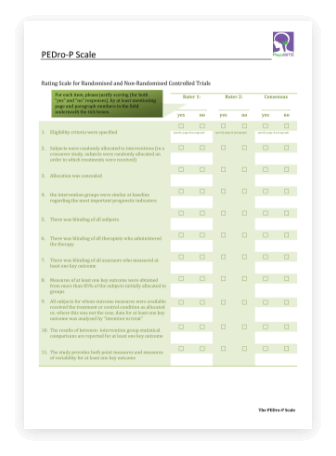Group Comparison Studies
speechBITE uses the PEDro-P scale to assess the methodological quality of two types of group comparison research designs: randomised controlled trials and non-randomised controlled trials. Methodological quality can be defined as “the likelihood of the trial design to generate unbiased results, that are sufficiently precise and allow application in clinical practice” (Verhagen et al, 2001).
About the PEDro-P Scale
The PEDro-P scale is an 11 item rating scale. The scale assesses the internal validity of a clinical trial and whether it contains sufficient statistical information to make it interpretable.
Criterion 1 on the scale relates to external validity, and is not counted in the final methodological quality rating score which is out of 10.
Criterion 2-9 assess internal validity and address biases prior to the treatment phase (random allocation, concealed allocation and groups being statistically similar at baseline) performance biases during treatment (blinding of participants, therapists and assessors) and biases at data analysis (drop out rates and intention to treat analysis). Criterion 10 and 11 assess the interpretability of the findings by looking at between group statistical comparisons and the reporting of point estimates and measures of variability.
The PEDro-P scale was derived from the original PEDro scale. The PEDro scale was developed by a group of researchers from the University of Sydney for use on the PEDro website (Sherrington, Herbert, Maher & Moseley, 2000). The PEDro scale incorporates all 9 items of clinical trial quality identified in the Delphi list developed by Verhagen and colleagues (Verhagen et al, 1998). The PEDro scale contains 2 additional items on the adequacy of follow-up and statistical comparisons between treatment groups. For more information in the reliability of the PEDro scale see Maher et al (2003).
The only difference between the PEDro-P scale and the original PEDro scale is in the way criterion 4 is defined and applied. The PEDro-P scale was adapted by NeuroBITE.
Important Considerations
The PEDro-P scale score should not be used as a measure of the “validity” of an author’s conclusions and related recommendations. It is important to note that a study with a high score on the PEDro-P scale will not necessarily mean that the treatment will be useful in clinical practice. Consideration should also be given to factors such as the size of the treatment effect, the use of appropriate statistical analyses, the appropriateness of outcomes chosen, the inclusion of important prognostic variables and whether positive effects outweigh any potential negative effects.
Also important to note is that scores for each criterion can only be awarded on the basis of what is explicitly reported in the paper being rated. As such, a low score may mean that the article did not contain sufficient details in regard to its design, method and statistical analyses.
Find answers to frequently asked questions (FAQs) about ratings.

Download a copy of the PEDro-P scale (PDF 93kb).
